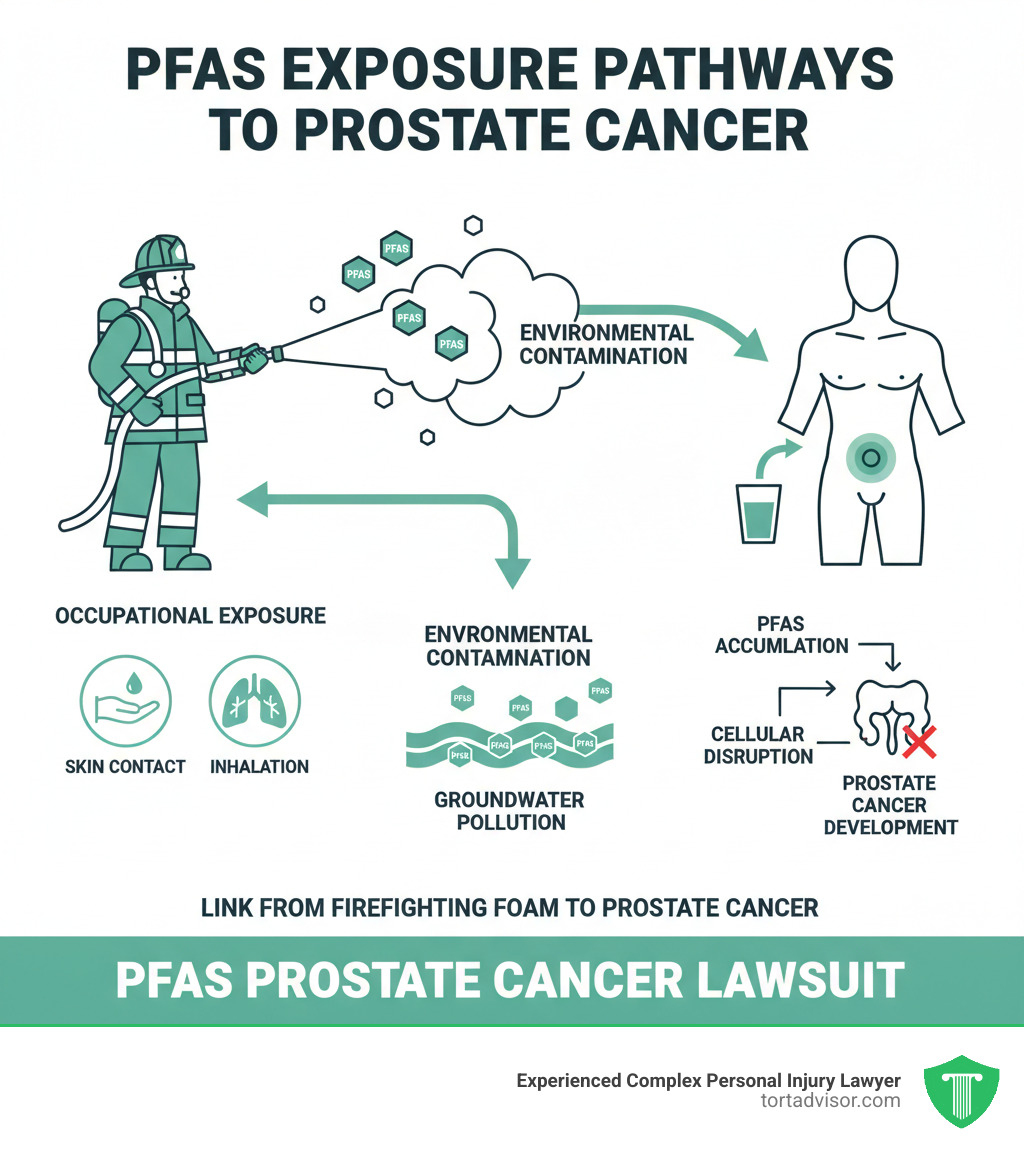


PFAS Exposure is Linked to Prostate Cancer – Here’s What You Need to Know
A pfas prostate cancer lawsuit may be an option if you developed prostate cancer after exposure to “forever chemicals” found in firefighting foam and other products. These cases are gaining momentum as research continues to show strong links between PFAS exposure and cancer.
Quick Facts About PFAS Prostate Cancer Lawsuits:
- Who can file: Firefighters, military personnel, and residents near contaminated sites who developed prostate cancer
- Key evidence needed: Medical records showing prostate cancer diagnosis and proof of PFAS exposure
- No upfront costs: Attorneys work on contingency fee basis
- Current status: Thousands of cases consolidated in federal court (MDL 2873)
- Settlement estimates: $150,000 to $375,000+ for strong cases based on similar mass tort settlements
PFAS (per- and polyfluoroalkyl substances) are man-made chemicals used in firefighting foam called AFFF. These “forever chemicals” don’t break down naturally and build up in your body over time.
Military members may be twice as likely to develop prostate cancer compared to civilians, according to research from Zero Cancer. This alarming statistic highlights the connection between occupational PFAS exposure and cancer risk.
The strongest cases involve:
- Firefighters who used AFFF foam regularly
- Military personnel stationed at bases with known contamination
- Residents who drank contaminated water near military bases or airports
Through our work connecting people with experienced attorneys, we’ve seen how pfas prostate cancer lawsuit cases can provide crucial compensation for medical expenses and other damages. Our expertise helps us understand the complex data and research behind these toxic exposure cases.
Pfas prostate cancer lawsuit vocab to learn:
- PFAS Cancer Risk Complete Guide
- PFAS Exposure Risks
- PFAS Lawsuit Settlement Amounts Per Person
The Scientific Link: How PFAS and AFFF Lead to Prostate Cancer
Per- and polyfluoroalkyl substances (PFAS) are persistent, man-made chemicals that have woven their way into our lives and bodies. Known for their resistance to heat, water, and oil, their usefulness in many products is also what makes them dangerous. The strong carbon-fluorine bond in PFAS prevents them from breaking down easily in the environment or the human body, earning them the name ‘forever chemicals.’
One of the most significant sources of PFAS contamination, particularly relevant to prostate cancer claims, is Aqueous Film-Forming Foam (AFFF). AFFF is a specialized firefighting foam designed to quickly extinguish highly flammable liquid fires, especially those involving petroleum products. Its effectiveness comes directly from the PFAS it contains.
The core concern here is bioaccumulation. Once PFAS enter the body, they tend to stay there, accumulating over time. Scientific research, including studies from the National Cancer Institute, indicates that PFOA and other per-fluorinated chemicals may be associated with an increased risk for prostate cancer incidence and mortality. The mechanisms behind this link are still being fully explored, but they are believed to involve endocrine disruption—interfering with the body’s hormones—and other cellular damage. For more information on the broader risks, you can explore our PFAS Cancer Risk Complete Guide.
What are PFAS Chemicals?
PFAS chemicals are a family of thousands of man-made compounds that have been in production since the 1940s. They are often referred to as “forever chemicals” because their chemical structure makes them extremely stable and resistant to degradation. The two most well-known types, often at the forefront of health discussions and lawsuits, are Perfluorooctanoic Acid (PFOA) and Perfluorooctane Sulfonate (PFOS).
Their unique properties—repelling water, grease, and oil, and stability at high temperatures—made them ideal for a vast array of applications, including:
- Non-stick cookware (like Teflon)
- Water-resistant clothing and outdoor gear
- Stain-resistant carpets and upholstery
- Food packaging (pizza boxes, microwave popcorn bags)
- Personal care products (some cosmetics and dental floss)
- Industrial applications (chrome plating, electronics manufacturing)
- And, of course, firefighting foams, particularly AFFF.
The widespread use of PFAS means that virtually everyone has some level of these chemicals in their blood. The U.S. Environmental Protection Agency (EPA) has issued a health advisory for PFOA and PFOS, acknowledging the potential harm from long-term exposure.
How Does PFAS Exposure Affect the Body?
A major concern is the persistence of PFAS in the body. Unlike other toxins, they don’t easily break down or get excreted, instead accumulating in organs and tissues where they can cause harm.
One of the primary ways PFAS are believed to impact health is through hormone disruption. They can interfere with the endocrine system, which regulates crucial bodily functions, including growth, metabolism, and reproduction. For men, this hormonal interference can be particularly concerning for prostate health. Studies in 2021 even suggested that PFAS can lead to prostate cancer, and a high-fat diet can cause someone’s prostate cancer to progress more quickly.
Beyond hormonal disruption, PFAS exposure has been linked to:
- Cellular damage: Affecting how cells function and potentially leading to uncontrolled growth.
- Immune system dysfunction: Weakening the body’s ability to fight off infections and diseases, and potentially making it more susceptible to cancer.
- Liver damage: As the liver works to filter toxins, it becomes a target for PFAS accumulation.
The International Agency for Research on Cancer (IARC) has classified PFOA as a possible carcinogen, and PFOS as possibly carcinogenic to humans, underscoring the serious health implications. For a deeper dive into the signs your body might be giving you, check out our page on PFAS Exposure Symptoms.
What is AFFF and Why is it Dangerous?
Aqueous Film-Forming Foam (AFFF) is a firefighting foam popularized in the 1960s. Developed by the U.S. Navy and 3M, it was designed to fight highly flammable liquid fires, like those involving jet fuel. AFFF works by creating a vapor-suppressing film that quickly extinguishes fires, making it highly effective in critical situations.
The danger of AFFF lies in its active ingredients: PFAS chemicals. For decades, AFFF was widely used in both military and civilian settings, including:
- Military bases: For training exercises, emergency response, and equipment maintenance.
- Commercial airports: For fire suppression and drills.
- Industrial facilities: Where large-scale fuel or chemical fires were a risk.
The use of AFFF led to direct exposure for countless individuals. Firefighters and military personnel handling the foam were exposed through inhalation of fumes, skin contact, and accidental ingestion. Beyond direct contact, AFFF’s PFAS content has caused extensive environmental contamination. When the foam was used, it would seep into the ground, contaminating soil, groundwater, and nearby drinking water sources. This insidious spread means that even those who never directly handled AFFF could be exposed through contaminated water. The Centers for Disease Control and Prevention (CDC) and the Environmental Protection Agency (EPA) have both warned about the toxic chemicals in AFFF firefighting foam, stating that exposure may contribute to certain health risks. To learn more about the broader legal landscape, visit our Firefighting Foam Cancer Lawsuit page.
High-Risk Groups for PFAS Exposure and Prostate Cancer
Understanding who is most at risk for PFAS exposure and subsequent health issues like prostate cancer is crucial. The nature of these “forever chemicals” means exposure can occur in various ways, from direct occupational contact to simply drinking tap water.
We’ve observed that individuals in certain professions and those living near specific contaminated sites face a significantly higher likelihood of exposure. For a comprehensive look at the various ways people can come into contact with these hazardous substances, please refer to our PFAS Exposure Risks guide.
Firefighters and Airport Personnel
Firefighters and airport personnel, the heroes on the front lines, were unknowingly put at risk every time they used AFFF to extinguish fires.
These brave individuals experienced some of the most direct and intense PFAS exposure through:
- Direct handling of AFFF: Mixing, deploying, and cleaning up the foam during actual emergencies and routine training drills.
- Inhalation of fumes: The aerosols and vapors released during AFFF deployment could be easily inhaled.
- Skin absorption: Direct contact with the foam, even through protective gear, could lead to skin absorption of PFAS.
- Contaminated protective gear: PFAS chemicals were not only in the foam but also used to make some firefighting gear water and stain-resistant, leading to prolonged exposure.
Many firefighters, particularly those in municipal departments, military installations, and commercial airports, have served for decades, meaning chronic, high-level exposure. Researchers at the National Research Centre for Environmental Toxicology (Australia) found that firefighters were more likely to have fluorinated surfactants in their bloodstream. This direct and repeated exposure places them in a high-risk category for developing PFAS-related cancers, including prostate cancer.
Military Service Members and Veterans
Military service members were also unknowingly subjected to significant PFAS exposure. AFFF was the gold standard for fighting fuel fires on military bases worldwide, and its widespread use led to extensive contamination.
Many military bases across the United States are known to have significant levels of PFAS contamination. The Department of Defense has identified 715 military installations that require an assessment of per- and polyfluoroalkyl substances (PFAS). This means that anyone who served on these bases, or lived nearby, could have been exposed.
The link between military service and prostate cancer is concerning. Some studies suggest that military members are twice as likely to have prostate cancer as civilians. This disproportionate risk is often attributed to occupational exposures, with PFAS being a prime suspect.
High-risk military roles and exposure pathways include:
- Air Force Firefighters: Directly engaged with AFFF.
- Navy Personnel: Exposed on ships and at shipyards where AFFF was used. People who have worked in the U.S. Navy may have been exposed to PFAS in firefighting foam.
- Army and Marine Corps Personnel: Engaged in fire training or stationed at bases with contaminated water.
- All Personnel: Who consumed contaminated drinking water on base. In fact, many military bases across the United States are known to have significant levels of PFAS contamination. You can view an interactive map of military bases with known PFAS contamination to see if your base was affected.
The VA acknowledges that PFAS exposure during military service may increase someone’s risk of developing certain cancers. This recognition is a critical step for veterans seeking justice.
Residents Near Contaminated Sites
The risk extends beyond occupational exposure. The insidious nature of PFAS means environmental contamination can affect entire communities. AFFF is the number one contributor to PFAS-contaminated drinking water, having a devastating environmental impact.
Residents living near the following locations are particularly vulnerable to PFAS exposure:
- Military bases: As discussed, widespread AFFF use has led to contaminated groundwater that often extends beyond base perimeters.
- Commercial airports: Similar to military bases, airports frequently used AFFF, leading to localized contamination.
- Industrial manufacturing plants: Facilities that produced PFAS or used them in their manufacturing processes (e.g., chemical plants, textile mills) are significant sources of environmental release.
These communities often face contaminated municipal water supplies, or rely on private wells that have been impacted by PFAS runoff. Over 200 million Americans are estimated to live in areas with tap water that exceeds the EPA’s recommended safety levels for PFAS. The health implications for these communities, including an increased risk of prostate cancer, are profound. For more information on the legal actions being taken to address this widespread issue, explore our section on PFAS Cancer Water Contamination Lawsuits.
Filing a PFAS Prostate Cancer Lawsuit
If you or a loved one has a prostate cancer diagnosis linked to PFAS exposure, you may have legal options. The complex legal landscape is built on product liability and negligence. Manufacturers are being held accountable for failing to warn the public and regulators about the known dangers of PFAS.
Many companies, including 3M and DuPont, allegedly knew about the toxic effects of PFAS for decades but continued their production and sale. This failure to warn, coupled with the widespread environmental contamination caused by their products, forms the basis of many lawsuits.
The majority of individual personal injury lawsuits related to AFFF and PFAS exposure have been consolidated into a Multidistrict Litigation (MDL) known as MDL 2873, in the U.S. District Court for the District of South Carolina. An MDL streamlines the legal process for similar cases, making it more efficient. Within an MDL, “bellwether trials” are often conducted. These are test cases that go to trial to give all parties an idea of how juries might respond to the evidence and arguments, which can then inform settlement negotiations for the remaining cases. For the latest developments in this evolving legal battle, we encourage you to review our PFAS Lawsuit Update Today.
How to Qualify for a Lawsuit
Qualifying for a pfas prostate cancer lawsuit involves meeting specific criteria to establish a strong claim. Our team at Tort Advisor can help you steer these requirements, but generally, you’ll need to demonstrate:
- Proof of PFAS Exposure: We must show you were exposed to PFAS, particularly from AFFF or contaminated water. This could include:
- Employment records: If you worked as a firefighter (civilian or military), in an airport, or in an industrial setting where AFFF was used.
- Military service records: Documentation of your service on specific military bases known for PFAS contamination.
- Residence history: Proof that you lived near a contaminated site (military base, airport, industrial plant) and consumed contaminated drinking water.
- Water testing results: Evidence of PFAS in your drinking water.
- Medical Diagnosis of Prostate Cancer: You need a confirmed diagnosis from a medical professional, including the date and details of the cancer’s progression and treatment.
- Linking Exposure to Diagnosis: Scientific evidence and expert testimony are crucial to demonstrate that your PFAS exposure likely contributed to your prostate cancer. A growing body of research supports this link.
Determining eligibility can be complex, but we’re here to help simplify the process. For a detailed breakdown of the necessary qualifications, please visit our PFAS Lawsuit Criteria page.
Evidence Needed for a PFAS Prostate Cancer Lawsuit
Building a strong pfas prostate cancer lawsuit requires meticulous evidence collection to prove your PFAS exposure, your prostate cancer diagnosis, and the link between them. Key evidence includes:
- Medical Records: Comprehensive medical documentation is paramount. This includes your prostate cancer diagnosis, biopsy results, pathology reports, treatment history (surgeries, radiation, chemotherapy), and any records detailing the onset and progression of your condition. A doctor’s testimony or medical expert report can further solidify the link between PFAS and your cancer.
- Employment History: If your exposure was occupational, detailed records of your employment as a firefighter, military personnel, or in a relevant industrial setting are essential. This includes dates of service, specific roles, and any documentation of AFFF use or exposure incidents.
- Military Service Records: For veterans, your service records, including deployment locations and dates, are critical. We can cross-reference these with known contaminated military bases.
- Personal Testimony: Your own account of exposure, symptoms, and the impact of prostate cancer on your life provides a human element to your claim. Family members can also offer supporting testimony.
- Environmental Reports and Water Test Results: If your exposure was through contaminated drinking water, reports showing PFAS levels in your residential area’s water supply, or personal well testing results, are vital.
- Expert Testimony on Causation: Legal and medical experts will be called upon to explain the scientific link between PFAS exposure and prostate cancer, demonstrating that your exposure was a significant contributing factor to your illness.
Gathering this evidence can be overwhelming, especially while dealing with a cancer diagnosis. That’s where our experienced attorneys step in. We work diligently to collect and organize all necessary documentation to build the strongest possible case on your behalf.
Damages and Potential Settlement Amounts in a PFAS Prostate Cancer Lawsuit
A successful pfas prostate cancer lawsuit could entitle you to significant compensation (“damages”) for losses incurred due to your illness and manufacturer negligence. Damages typically sought include:
- Medical Expenses: This covers all past and future costs associated with your prostate cancer treatment, including doctor visits, diagnostic tests, surgeries, medications, radiation, chemotherapy, and rehabilitation.
- Lost Wages and Loss of Earning Capacity: If your cancer or its treatment forced you to miss work, prevented you from returning to your previous job, or reduced your earning potential, you can seek compensation for these financial losses.
- Pain and Suffering: This non-economic damage compensates you for the physical pain, emotional distress, mental anguish, and diminished quality of life caused by your prostate cancer.
- Loss of Consortium: If your prostate cancer has negatively impacted your relationship with your spouse, they may also be able to claim damages for the loss of companionship, affection, and support.
- Punitive Damages: In some cases, if a court finds that the manufacturers acted with extreme negligence or malicious intent, punitive damages may be awarded to punish the defendants and deter similar conduct in the future.
Estimating settlement amounts for AFFF/PFAS lawsuits, especially for specific cancers like prostate cancer, can be challenging as each case is unique. However, based on previous mass tort cases involving similar toxic exposures, legal experts have provided some projections. The average AFFF settlement could be between $100,000 and $300,000, with top-tier cases involving severe illnesses and clear exposure potentially reaching $150,000 to $375,000+. These are estimates and not a guarantee, but they provide a general idea of potential compensation.
To get a clearer picture of what your claim might be worth, we invite you to use our interactive PFAS Settlement Calculator. For more general information on potential payouts, you can also explore our page on PFAS Lawsuit Settlement Amounts Per Person.
Frequently Asked Questions about PFAS and Prostate Cancer
We understand you likely have many questions about PFAS, prostate cancer, and your legal rights. Here, we address some of the most common inquiries we receive.
What are other long-term health effects of PFAS exposure?
Beyond prostate cancer, PFAS exposure is linked to a wide range of serious health problems. These ‘forever chemicals’ can harm multiple bodily systems, and research consistently connects PFAS to:
- Kidney cancer: A study published in the Journal of the American Medical Association found a statistically significant association between PFOA exposure and an increased risk of kidney cancer.
- Testicular cancer: This same JAMA study also found a link between PFOA exposure and an increased risk of testicular cancer.
- Thyroid disease: PFAS chemicals can disrupt thyroid hormones, leading to conditions like hypothyroidism and hyperthyroidism, which can escalate to thyroid cancer over time.
- Ulcerative colitis: Another finding from the JAMA study linked PFOA exposure to ulcerative colitis, a chronic inflammatory bowel disease.
- Liver damage: The liver is particularly vulnerable to PFAS accumulation, leading to various liver diseases, including cancer.
- Suppressed immune function: PFAS can weaken the immune system, making individuals more susceptible to infections and reducing vaccine effectiveness.
- Bladder cancer: PFAS exposure has been found to present an increased risk for bladder cancer.
- Breast cancer: The International Journal of Cancer found a positive association between PFOS exposure and breast cancer.
- Developmental delays: In children, PFAS exposure has been linked to developmental issues.
- Reproductive harm and decreased fertility: PFAS can impact reproductive health in both men and women.
These widespread health impacts underscore the urgent need to address PFAS contamination and hold responsible parties accountable.
What are the legal options for veterans with prostate cancer?
Veterans with prostate cancer linked to PFAS exposure during service have several legal options:
- VA Disability Benefits: The Department of Veterans Affairs acknowledges that PFAS exposure may increase someone’s risk of developing certain cancers. While the VA has not officially recognized PFAS as a direct cause of prostate cancer, they are actively investigating the link, particularly between PFAS exposure and kidney cancer. The VA’s acknowledgement of PFAS exposure risks is a significant step. Veterans can file for disability compensation through the VA. The Sergeant First Class (SFC) Heath Robinson Honoring our Promise to Address Comprehensive Toxics (PACT) Act has expanded healthcare and benefits for veterans exposed to toxic substances, which may include PFAS-related conditions.
- Filing a Civil Lawsuit Against Manufacturers: Veterans can join civil lawsuits against the manufacturers of PFAS chemicals and AFFF firefighting foam (e.g., 3M, DuPont). Veterans are not suing the U.S. government in these cases. Instead, they are seeking compensation from the corporations that produced and sold these harmful chemicals, allegedly knowing the risks but failing to warn consumers or regulators. These lawsuits aim to recover damages for medical expenses, lost wages, pain and suffering, and more.
We can help veterans steer VA benefits and civil lawsuits to pursue all available compensation.
How much does it cost to hire a lawyer for a PFAS lawsuit?
Access to justice shouldn’t be denied due to cost, especially when facing a serious illness caused by corporate negligence. That’s why we work on a contingency fee basis.
What does this mean for you?
- No Upfront Costs: You won’t pay any attorney fees out-of-pocket to start your pfas prostate cancer lawsuit.
- We Only Get Paid if You Win: Our fees are contingent upon the successful resolution of your case, whether through a settlement or a court verdict. If we don’t recover compensation for you, you don’t pay us attorney fees.
- Free Case Evaluation: We offer a free, no-obligation case evaluation to discuss your situation, assess the merits of your claim, and explain your legal options. This allows you to understand your potential lawsuit without any financial commitment.
This arrangement allows individuals and families to pursue justice against powerful corporations without the added stress of legal fees, making the legal system accessible to everyone.
Know Your Rights and Take Action
The link between pervasive PFAS chemicals and serious health conditions like prostate cancer is a profound public health challenge. For too long, manufacturers allegedly prioritized profit over safety, leaving individuals and communities with devastating consequences.
We believe in holding these corporations accountable. If you or a loved one has received a prostate cancer diagnosis and have a history of PFAS exposure—whether through military service, firefighting, or living near a contaminated site—explore your legal options. You have rights, and compensation may be available to cover your medical expenses, lost income, and the immense pain and suffering you’ve endured.
Tort Advisor is dedicated to connecting victims with top-rated specialty attorneys who have a proven track record of success in complex personal injury and toxic tort cases. Our network includes highly skilled legal professionals across the nation, ready to fight for the justice you deserve.
Don’t face this battle alone. The legal process can be daunting, but with experienced legal representation, you can steer it effectively. If you or a loved one has been diagnosed with prostate cancer after PFAS exposure, explore your legal options for a PFAS Cancer Lawsuit. Contact us today for a free consultation, and let us help you understand your rights and take the first step towards securing your future.
Free Confidential Case Evaluation
Complete the short form below to get an immediate FREE case review with an expert in your specific claim. Don't wait, your case could be time sensitive to file a claim.
Related Posts
Did a North Dakota product cause harm? Understand product liability, your rights, and how to take action for defects.
Get justice for clergy abuse. Find an expert Priest abuse lawyer to navigate complex laws and hold institutions accountable.
Diagnosed with meningioma after Depo-Provera? Understand potential Depo-Provera lawsuit settlements, risks, & how to claim compensation.
Uncover the truth about uber sexual assault cases. Learn about the alarming scale, Uber's accountability, and legal options for justice.
Facing wildfire losses? Discover the best wildfire lawsuit attorneys in California to fight for your full recovery and justice.
Exposed to Roundup & diagnosed with NHL? Discover how to sue Monsanto, understand eligibility, & seek compensation. Your guide to justice.









